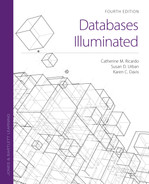5.1 Brief History of SQL in Relational Database Systems
The relational model was first proposed by E. F. Codd in 1970. D. D. Chamberlin and others at the IBM San Jose Research Laboratory developed the language now called SQL, or Structured Query Language, as a data sublanguage for the relational model. Originally spelled SEQUEL, the language was described in a series of papers starting in 1974, and it was used in a prototype relational system called System R, which was developed by IBM in the late 1970s. Under the direction of Larry Ellison, Bob Miner, and Ed Oates, an early commercial relational database management system (RDBMS), Oracle, was developed in the late 1970s using SQL as its language. Ingres, another early prototype RDBMS, was developed at the University of California at Berkeley by Eugene Wong and Michael Stonebraker. System R was evaluated and refined over a period of several years, and it became the basis for IBM’s first commercially available relational DBMS, SQL/DS, which was announced in 1981. IBM’s DB2, also using SQL as its language, was released in 1983. Microsoft SQL Server, MySQL, Informix, Sybase, PostgreSQL, Microsoft Access, Teradata, MariaDB, and many other RDBMSs have also incorporated SQL.
Both the American National Standards Institute (ANSI) and the International Standards Organization (ISO) adopted SQL as a standard language for relational databases and published specifications for the SQL language starting in 1986. This standard is usually called SQL1. A minor revision, called SQL-89, was published three years later. A major revision, SQL2, was adopted by both ANSI and ISO in 1992. The SQL2 standard covered the basic relational model. The SQL3 standard was developed over time, with major parts published in 1999, 2003, 2006, 2008, 2011, 2016, and 2019. By 2008, features included object-oriented data management capabilities, triggers, new data types, support for XML, and other capabilities. Support for temporal databases and window functions were added in 2011. The 2016 release included support for JavaScript Object Notation (JSON), row pattern matching, and polymorphic tables. The 2019 release focused on multidimensional arrays, an essential tool for big data.
Most vendors of RDBMSs have added features to the standard and use their own extensions of the language, creating a variety of dialects around the standard. Because some parts of the current standard are optional, not all vendors provide the full set of features described in the standard. This chapter will focus on the most widely used, strictly relational features that are available in most RDBMSs.
SQL has a data definition language (DDL), a data manipulation language (DML), and an authorization language. Readers should note that different implementations of SQL may vary slightly from the syntax presented here; however, the basic notions are the same. Commands given in this chapter generally use the Oracle syntax and may need slight modifications to run on other DBMSs.
